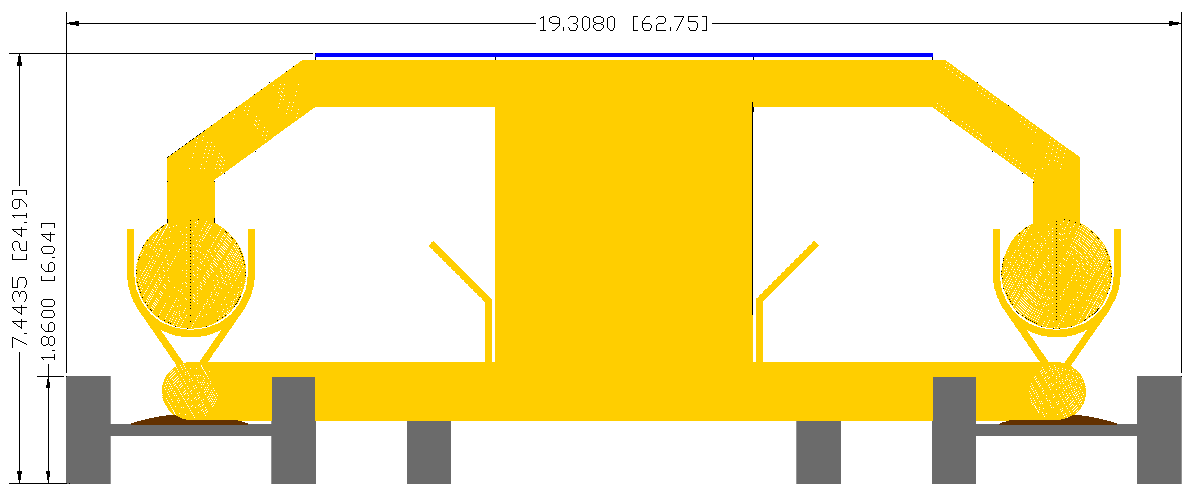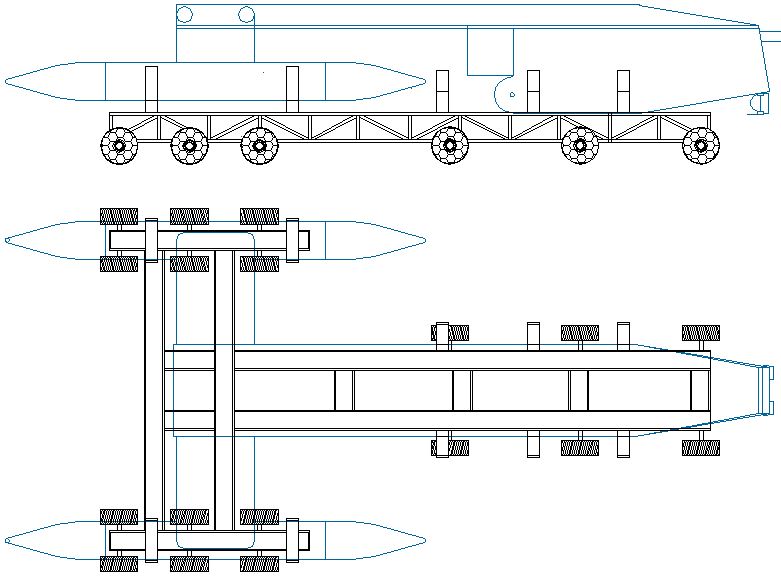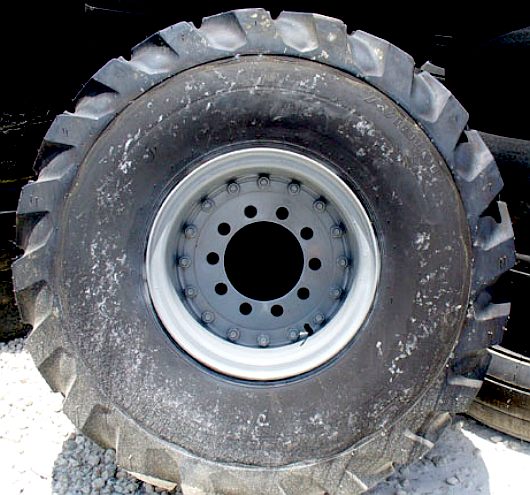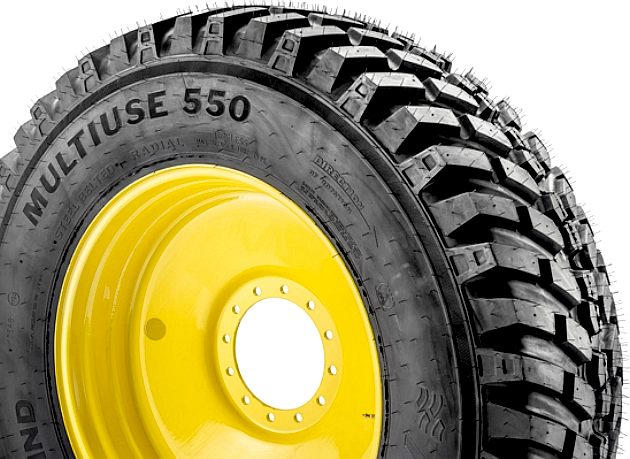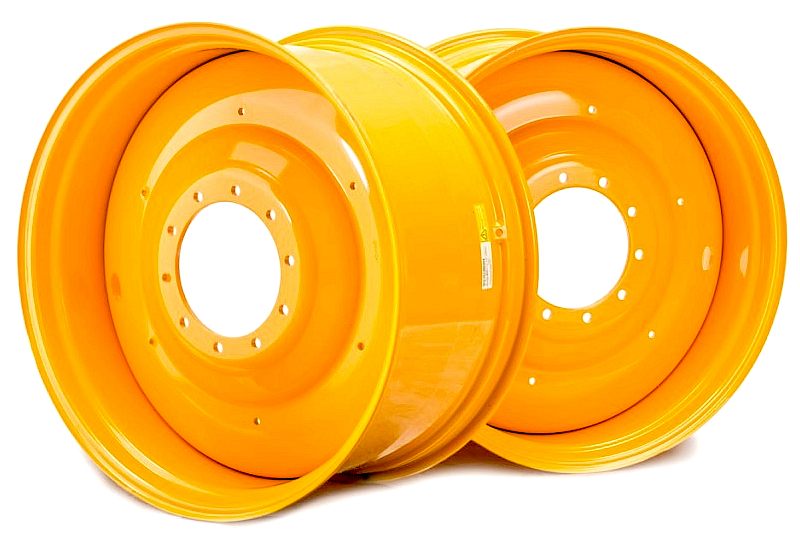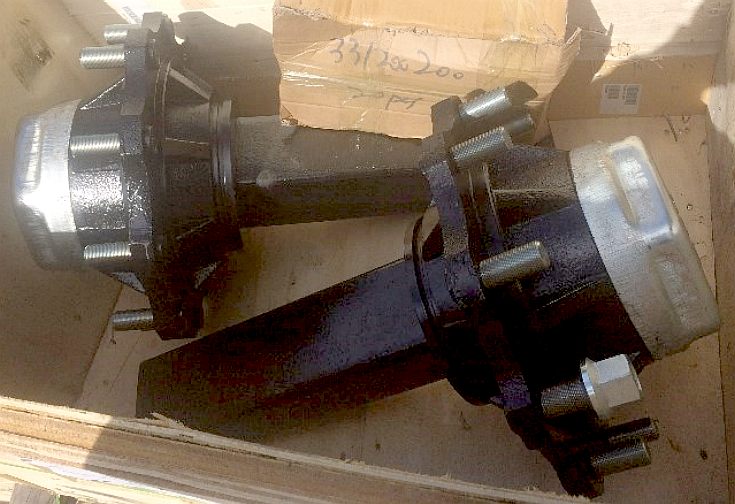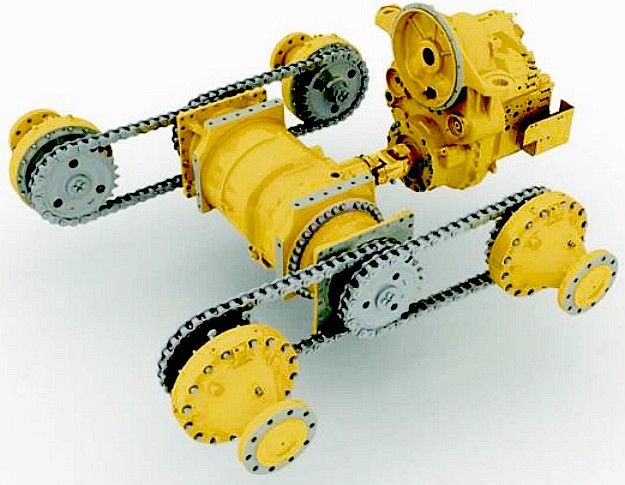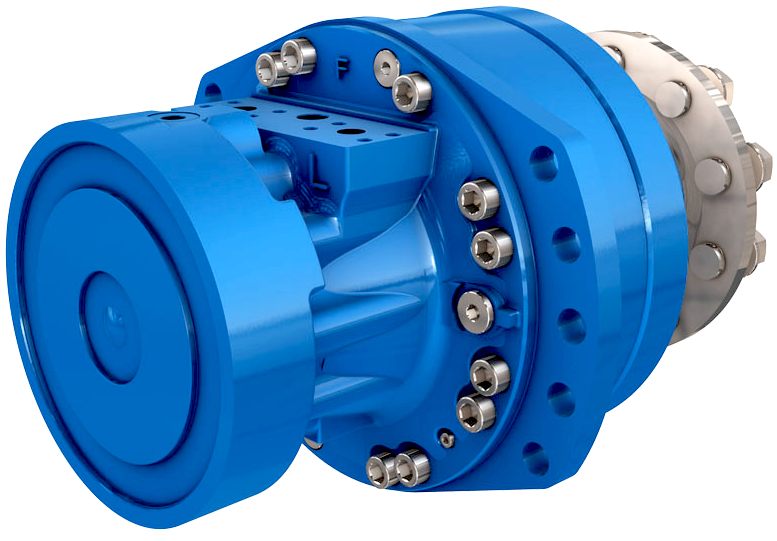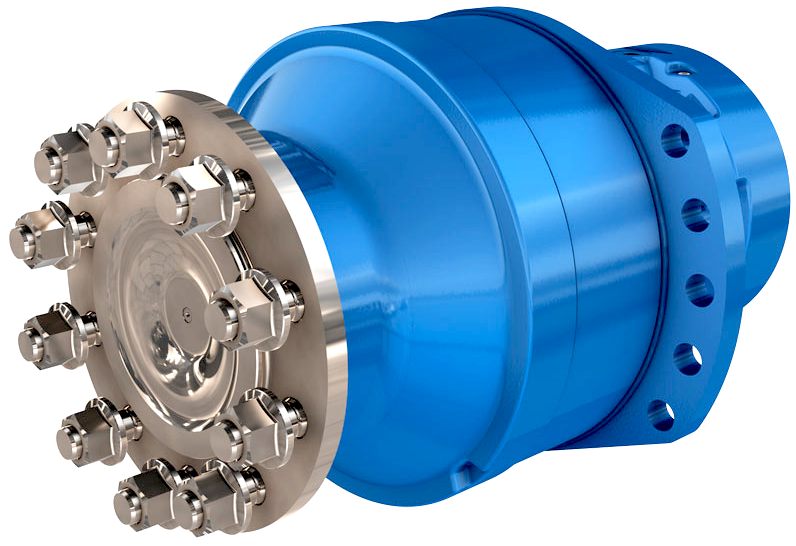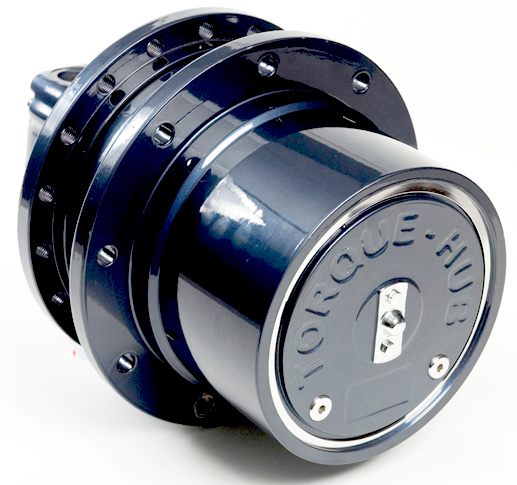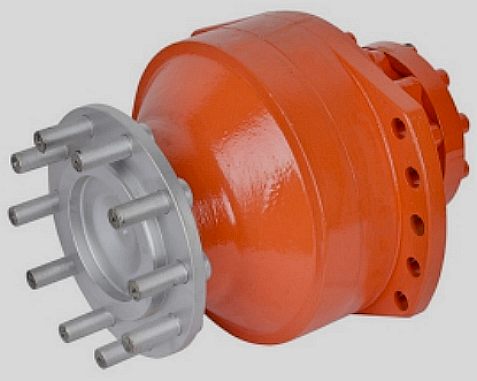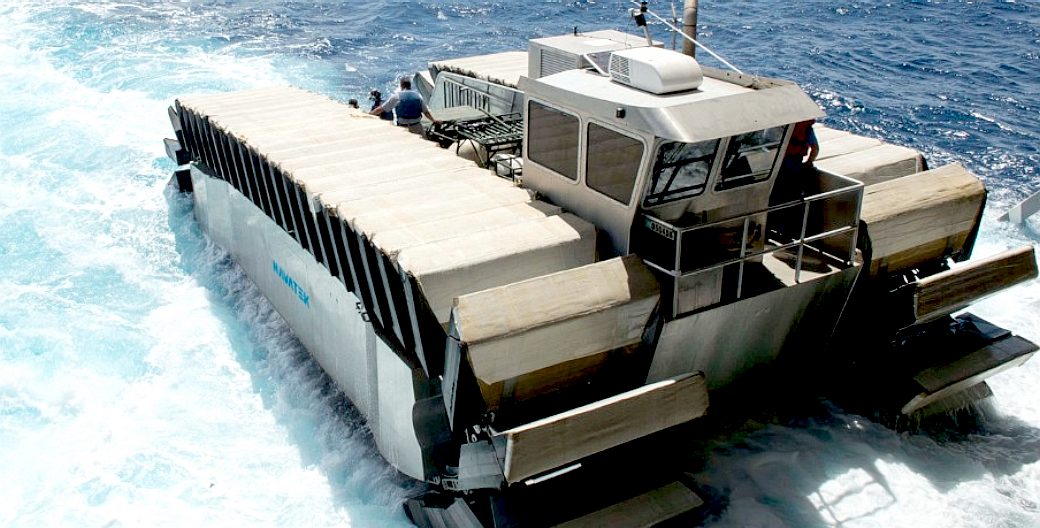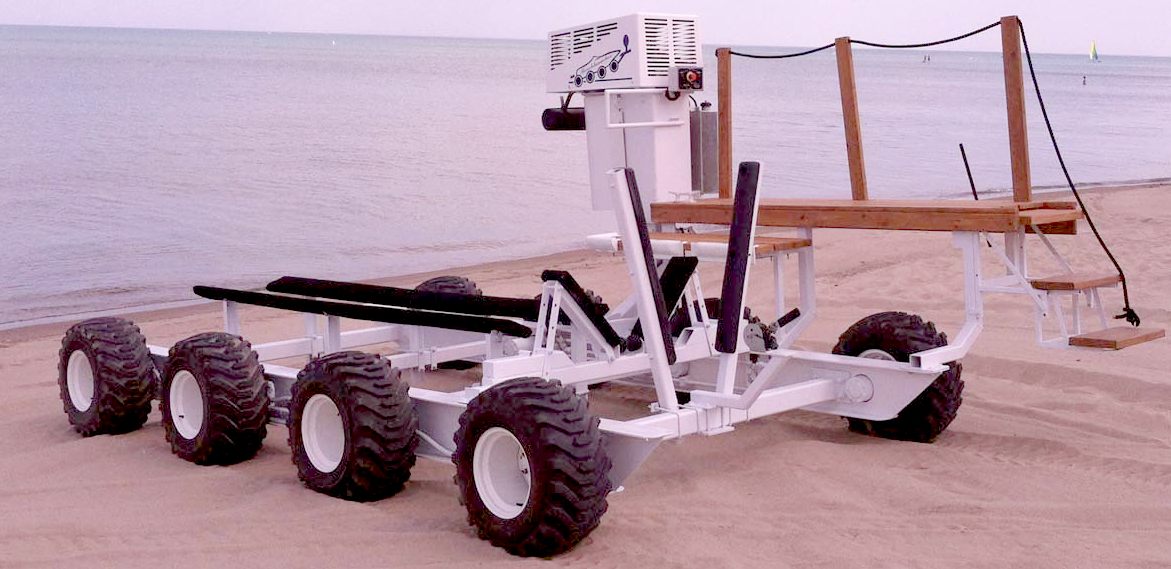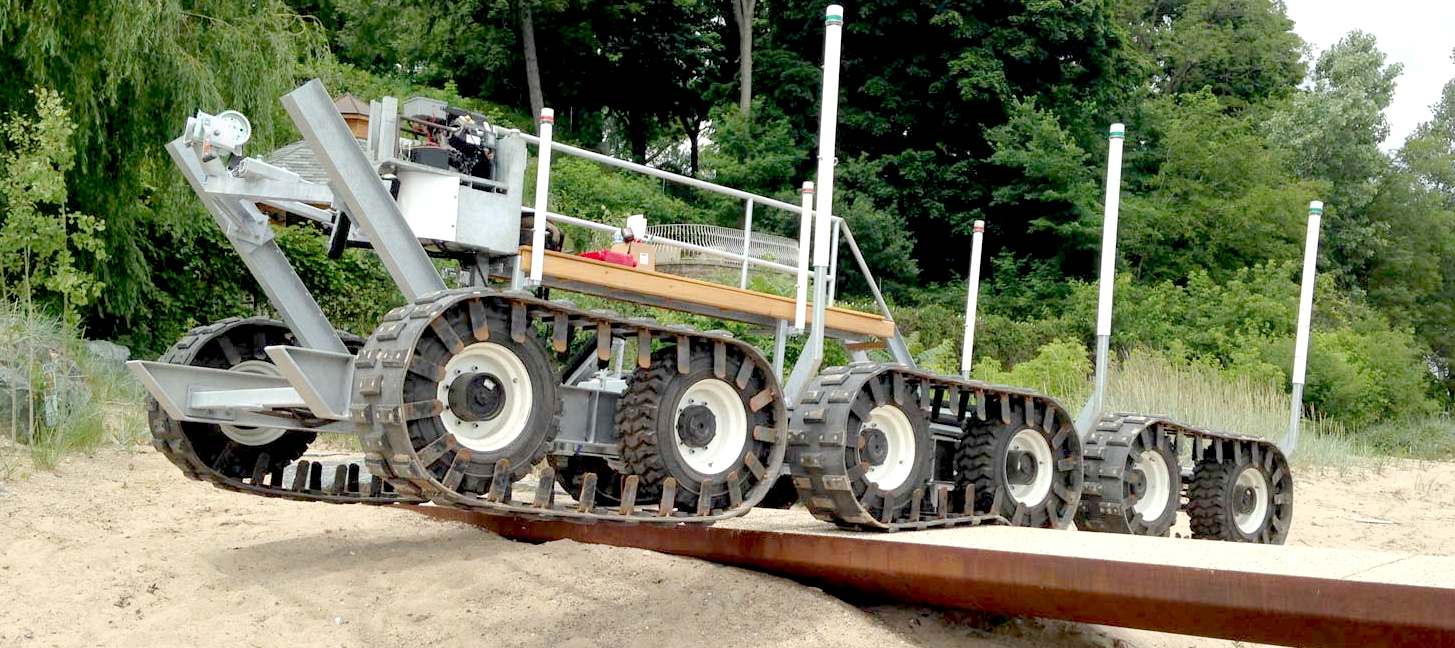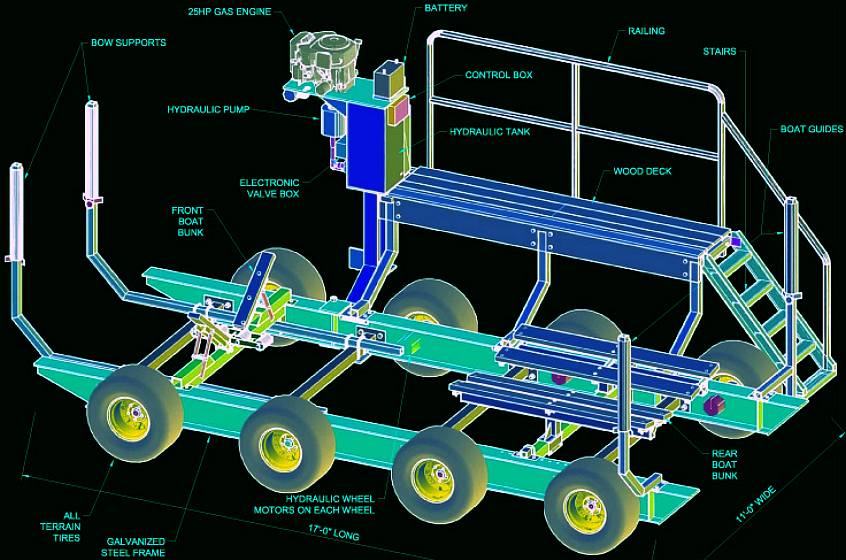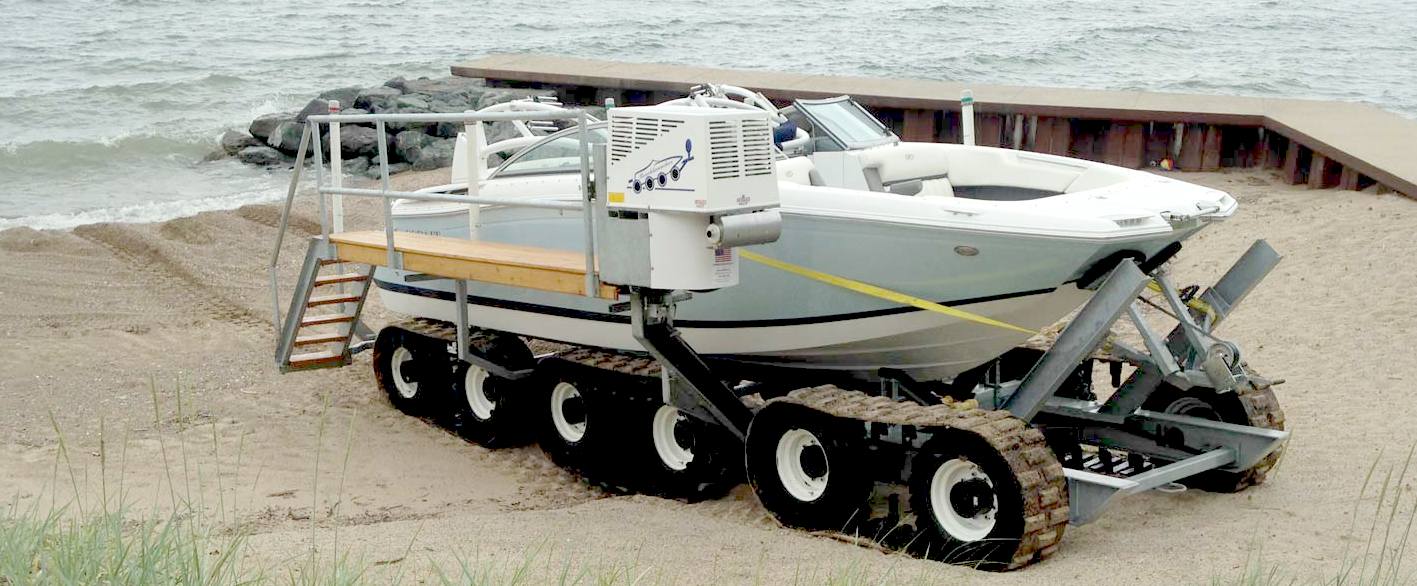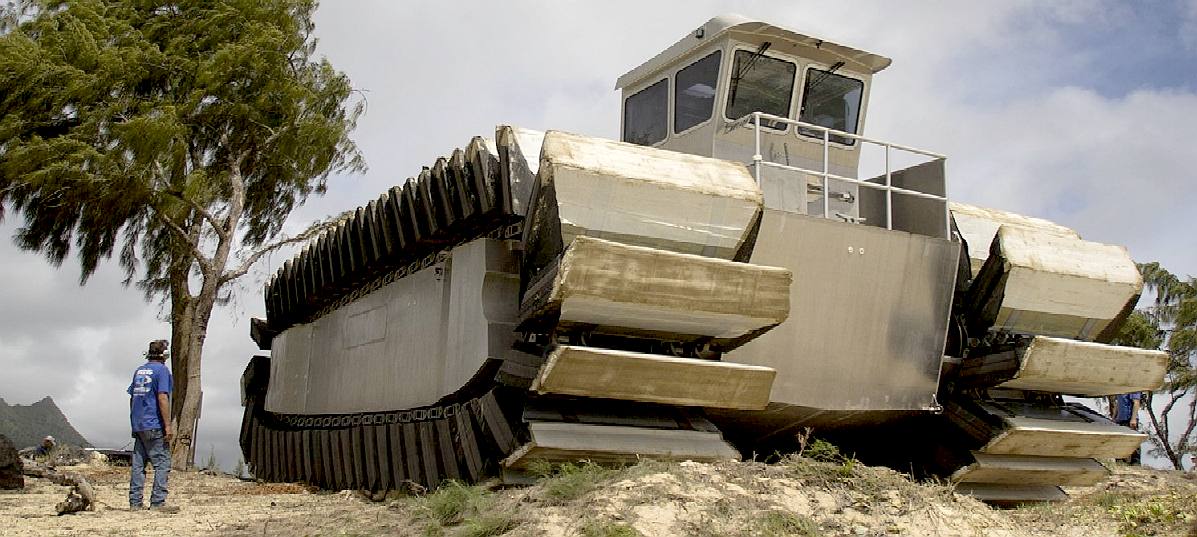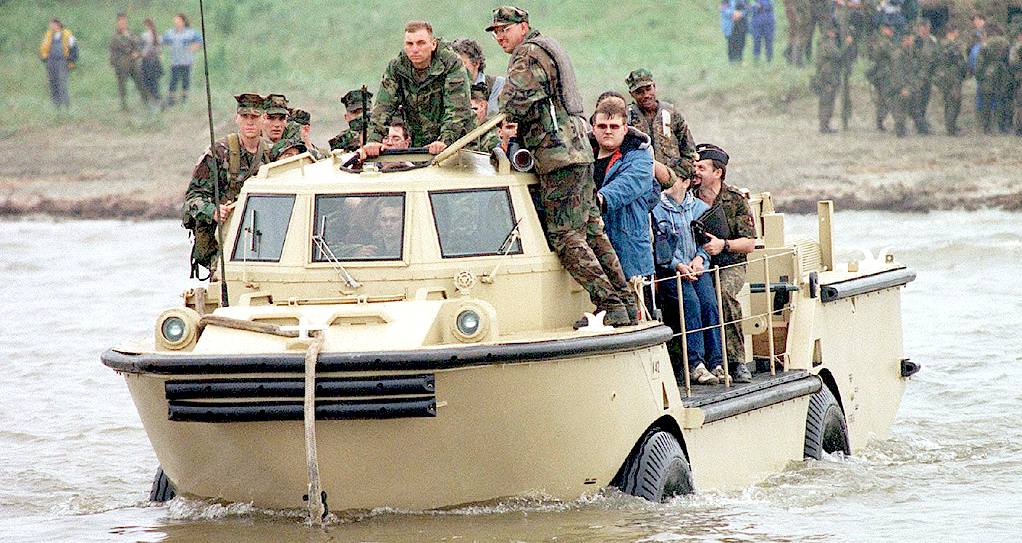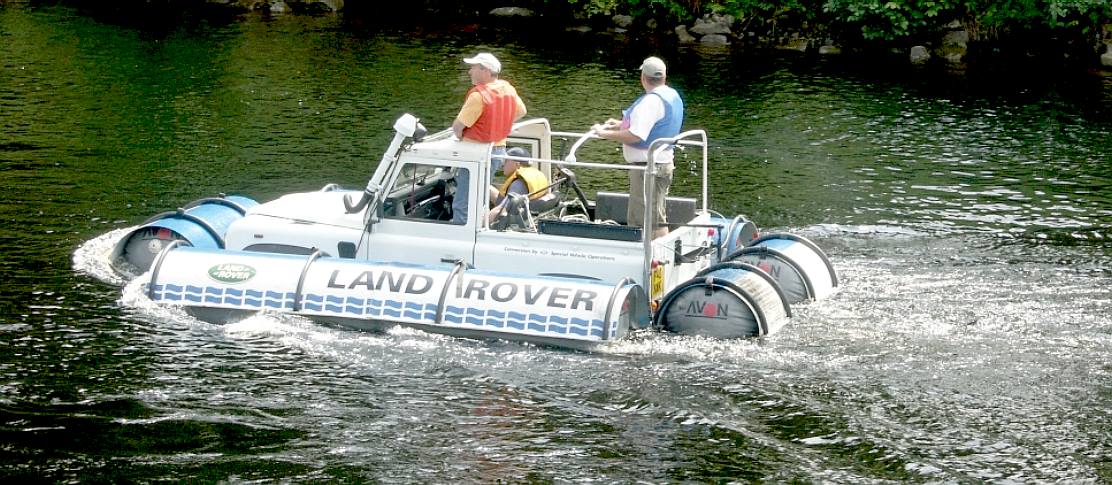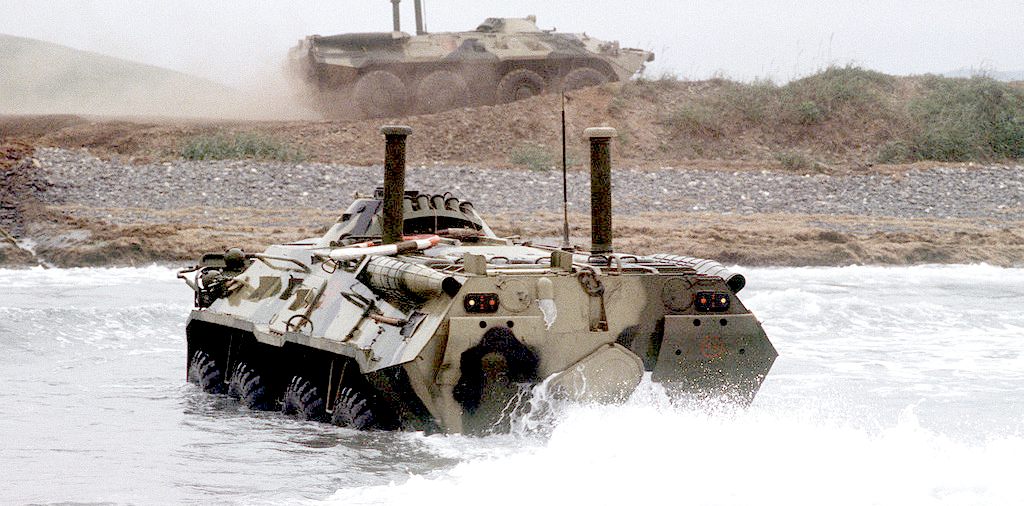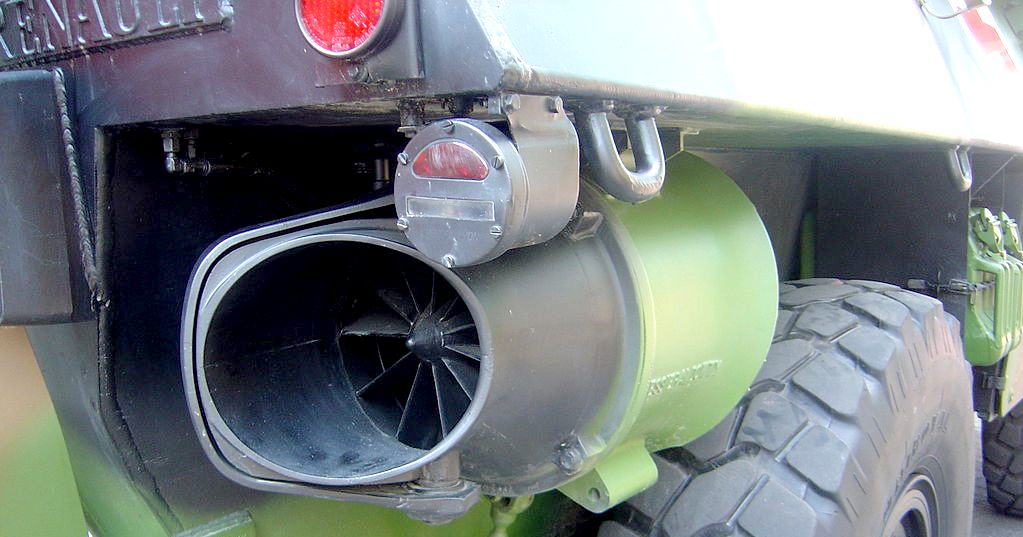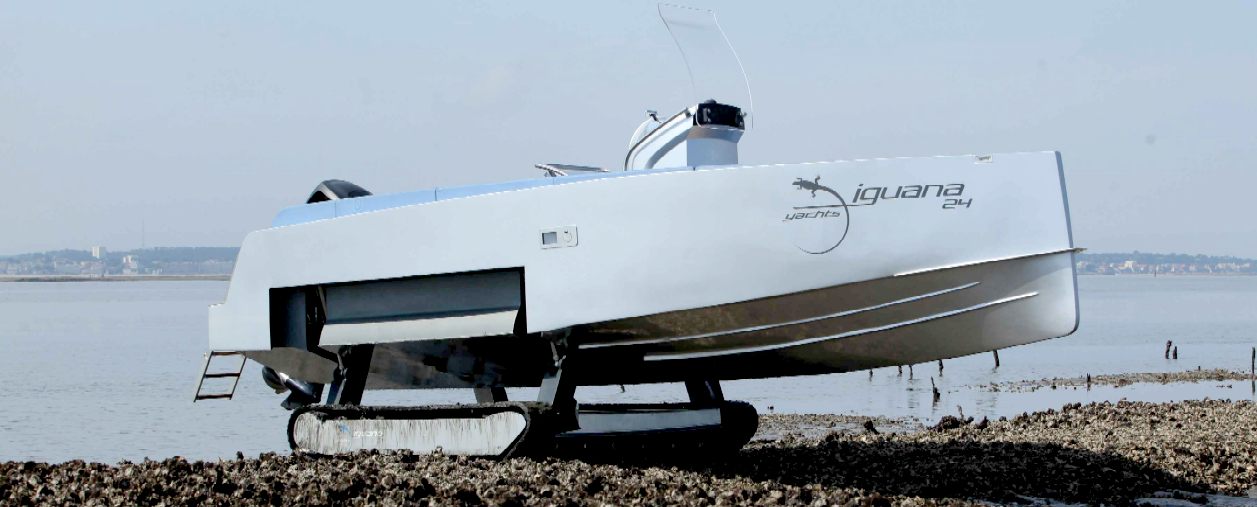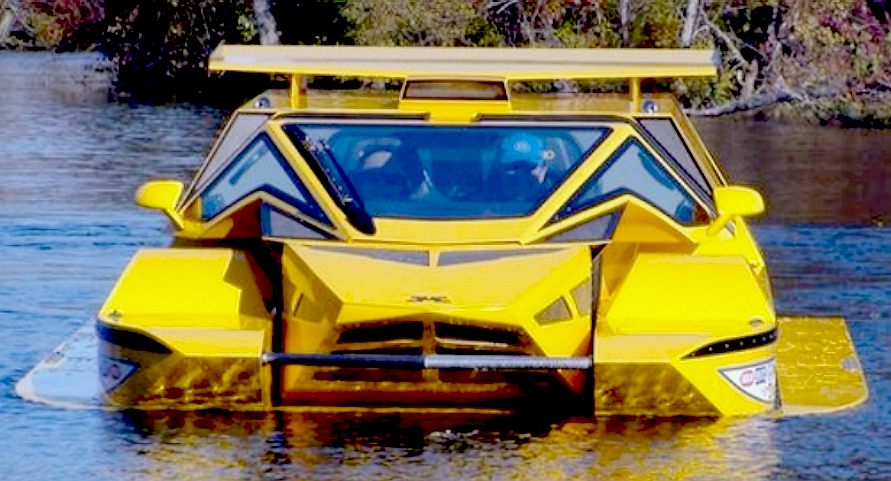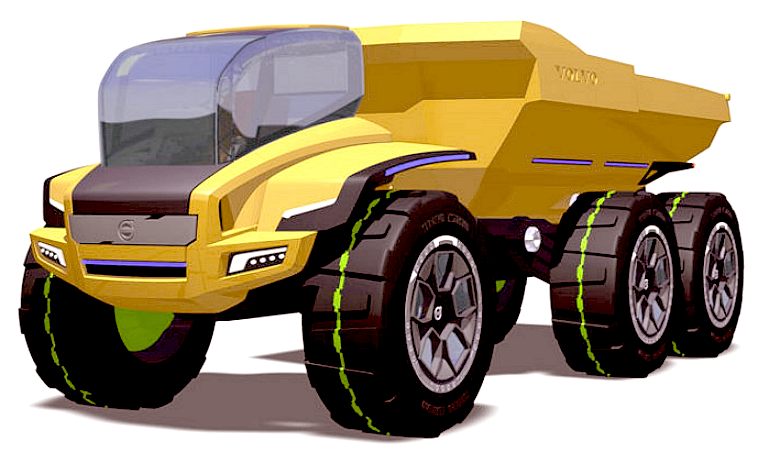|
AMPHIBIOUS LAUNCH - AMPHIMAX - CAB - CHASSIS - DIESELS - FLOATATION - HYDRAULICS - LAUNCH SITE - MODEL 1/20 - TIMETABLE - TRACKS - TRAILER - THRUSTERS - WHEELS
|
|||||||||||||||||||||||||||||||||||||||||||||||||||||||||||
|
BEACH LAUNCH METHODOLOGY - How do we launch a 45x17 meter (147.5 x 55 foot) trimaran from a sloping shoreline without any kind of special preparations to the beach? To answer that question we are looking at beach launching using a custom built trailer with a beefy tractor unit, and other design scenarios, such as the conceptual, amphibious solution on this page.
Including the mass of the trailer, we should be calculating all up weight as being in the region of 100 tons, with contingency for 140 tons. This is allowing a generous safety margin - just in case the SeaVax holds are not fully discharged. Though discharge is a requirement before recovery.
DRIVEN WHEELS- Economy of construction is a major consideration when operating on a limited budget. How then to power the driven wheels? To keep the design as simple as we can, we are not having steered wheels in the conventional sense - we are looking at variable track steering as employed on other tracked vehicles, such as tanks and bulldozers, where the wheels on one side go faster, or slower than on the other side - so that the vehicle turns, in the extreme being able to spin on its own axis.
There are two ways of powering such wheels when you don't want a complicated drive-shaft arrangement:
1. Hydraulic wheel motors, and
2. Electric wheel motors.
Which of the two systems is the most practical remains to be seen; the whole point of a feasibility study.
GETTING A GRIP - Tyre technology has come on in leaps and bounds in recent years. More earth moving and agricultural vehicles are being fitted with rubber that spreads the load and so reduces rolling resistance.
FLOATATION TYRES - Wide tyres spread the load preventing soil compaction and decreasing rolling resistance, so reducing the power required to simply move a large trailer. Nearly half of all modern agricultural and earth moving equipment is now fitted with floatation tyres as standard, compared to around 10% 5 years ago. Don't forget the basics, a larger wheel offers less rolling resistance and tends to iron out the bumps.
FLOATATION TIRE SIZES CHART HANDY REFERENCE FOR DESIGNERS
DRIVING FORCE - [ABOVE LEFT] An ideal layout for bogies with four wheels to drive. This is the transmission for the Caterpillar M16 grader. Chain drive is very efficient and simple, but subject to corrosion if not encased.
[ABOVE RIGHT] An electrically powered alternative that like the hydraulic drives below eliminates chains and drive shafts, but has its own set of problems, mainly the storage medium adding considerably to the mass of the vehicle. There are though many advantages to electric drives, such as for solar powered vehicles that remain on station for long periods, which might then generate the energy they need to move.
BEACH (HILL) CLIMBING ABILITY
To calculate the power required for a pure vertical lift you need to know that: 0.746 kW (1 horsepower) = 0.305 meters in one second. This is basic information for designing cranes and almost any machine that moves something. It was based the ability of a real animal to lift or pull a load, long before internal combustion engines were invented.
The "grade" or "incline" of a beach (here assuming a solid medium like a road for rolling resistance purposes) is the rise divided by the distance traveled. You can multiply the incline by the weight of the vehicle to find the force of gravity.
For example, if a trailer and boat weigh 2000 lbs and you are climbing up a 1% grade (1/100), there is 20 lbs (9.074 kg) of gravity force holding you back - so 20lbs of force is needed to stand still on this slope.
For our 100 ton (total load) amphibian @ 1% gradient that equates to: 2,240 lbs (1,016.4 kg) of gravity force, or 4 horsepower - just to stand still on a 1% slope.
On a 2% incline (2/100) we'd need 4,480 lbs (2,032 kg) or 8 horsepower to counteract gravity and on a 20% slope: 22,400 lbs or 80 horsepower (60kW) to cope with gravity. As we need to be able to deal with 30% slopes, we are looking at 120 hp (90kW) as the base motor output + the power to move our load up the beach in a reasonable time and that means speed of travel. In this case 5-15mph (8-24kph) would be more that adequate, equating to between 300-400kW or (400-535hp).
Clearly then, the slope of the beach is very important when calculating the power needed to recover SeaVax. An inconvenient thing about "weight" is that "kilograms" is a unit of mass, not a unit of force, so it must be converted to Newtons when considering torque and motor specification.
A vehicle reaches its maximum speed when available tractive effort balances out the sum of drag and downhill gravitational force, reducing the acceleration to zero. To go faster or cope with a steeper incline, you'd need to increase power. See the diagram below.
IN THIS DIAGRAM:
P(v)
is the tractive effort of the vehicle; B
is the brake force;
WORK DONE
The unit of work is the joule (J), so that 1 J is the work done in moving a force of 1 N through 1 m. Thus: 1J = 1Nm.
As
another example, if a typical car of a mass
of 1300 kg slides 100 meters down an icy slope, the slope being inclined at 30° to the
horizontal the forces acting on the car are:
DRIVING FORCE - This is a selection of off-the-shelf hydraulic wheel motors, most of which we could use for the AmphiVax™ launch & recovery vehicle. These are wheel hubs with a fluid motor drive inboard of the wheel mounting flange. They are the basis for the transmission of many popular earth moving vehicles.
ABOUT AMPHIBIOUS VEHICLES
An amphibious vehicle (or simply amphibian), is a vehicle that is a means of transport, viable on land as well as on (or under) water. Amphibious vehicles include amphibious bicycles, ATVs, cars, buses, trucks, military vehicles, and hovercraft.
Classic naval landing craft are not amphibious vehicles as they do not offer any real land transportation at all.
Most land vehicles – even lightly armoured ones – can be made amphibious simply by providing them with a waterproof hull and perhaps a
propeller. This is possible as a vehicle's displacement is usually greater than its weight, and thus it will float. Heavily armoured vehicles however sometimes have a density greater than water (their weight in kilograms exceeds their volume in litres), and will need additional buoyancy measures. These can take the form of inflatable floatation devices, much like the sides of a rubber dinghy, or a waterproof fabric skirt raised from the top perimeter of the vehicle, to increase its displacement.
ABOUT
AMPHIBIOUS
CARS
NAVATEK,
THE
CURRENT RECORD HOLDER JULY 2014 - The Marine Corps Warfighting Lab, in conjunction with the Office of Naval Research, is currently testing a beast of an amphibious lander.
THE
PREVIOUS RECORD HOLDER - The M3 Amphibious Rig is a self-propelled amphibious bridging vehicle that is used for the
conveyance of tanks and other vehicles across water obstacles.
MOON BUGGY - This is the Beachlauncher. Although it looks very much like the Moon Buggy, or indeed, somewhat like a Mars Rover, it is in fact a mobile, remote controlled self-propelled, all-terrain vehicle that launches boats and personal watercraft in and out of the sea. It looks very little like the boat trailer it replaces. It is operated by radio control and powered by a petrol engine and state-of-the-art hydraulics. The Beachlauncher has its own deck walkway and stairs attached, giving you a “mobile boat dock” for easy access to your boat so that you can avoid the spray as you launch. The Beachlauncher will mainly be used for recreational boating, but could be used for emergency services, such as a Lifeboat launch and retrieval, or for Coast Guard operations. The Beachlauncher was designed for a wide variety of shorelines, from inland lakes, rivers, ocean bays and sounds. It is currently in use throughout the Great Lakes, Canada and in the FIJI islands . The powered trailer can maneuver through many types of shoreline terrain consisting of sand and rocky debris, b it is not recommended for deep muddy conditions. Custom-built models are available upon request.
SPECIFICATIONS - The Beachlauncher can move a 16- to 32-foot boat with payloads ranging from 3,000 pounds (1,361kg) on the PWC-H model to 10,000 pounds (4,537kg) on the Superlauncher model, including boat, fuel and cargo. The vehicle can scale up a 12% (8:1) soft, rocky/sandy slope or a 25% (4:1) hard surfaced, ramped slope. The climbing ability will vary according to the local soil mechanics.
PERFORMANCE - The Beachlauncher’s performance comes from a compact hydraulics system coupled to a 25hp engine, though more power can be specified. The system gives The Beachlauncher durability for tough work in shoreline and marine environments, as well as volumetric efficiency for peak power output and enhanced mobility. Their steel chassis is made from "I" beam sections that are hot dip galvanized to protect against rust. The hull bunks are carpeted and may be adjusted to suit varying boat sizes.
BEACHLAUNCHER CONTACTS - Beachworks LLC, (office) 10134 N. Port Washington RD, Mequon, WI 53092 (factory) 1801 S Car Ferry Drive, Milwaukee, WI 5302. Telephone: 414.788-1562. Fax: 414.763.0464. Email: roger.tietz@gillenmarine.com
LIKE
MINDS - The Beachlauncher is a patented concept. Unlike a land based pier,
concrete ramp, or a conventional boat trailer, Beachlauncher is mobile, so
adapts to fluctuating water levels and shorelines so you can launch in low water or at low tide.
The self-propelled vehicle crosses shoreline terrain including sand, stone,
small rocks, silt and cobble. The Beachlauncher can be parked on your beach all year long. With its galvanized frame and motor cover, it’s protected from the elements. Many
customers choose to drive the Beachlauncher into boathouses or onto slabs. A 12-foot-wide x 10 foot high door is needed to accommodate the overall width of the boat and launcher. Your boat length will determine the depth of your boathouse, as The Beachlauncher 4000-H model is only 17 feet long and 11 ft. 1 in. wide.( with deck up ) Model 6000-H is 20 feet long and 11 ft. 1 in.
wide. The new "SPORT 4000" accommodates boats 16'-23' and is only 8 ft 6" wide.
CNN POLITICS NOV 2015 - MARINES TO SPEND $225M ON AMPHIBIOUS COMBAT VEHICLES
CNN AUGUST 2014
"The full-scale model should be able to carry at least three tanks and a HMMVW (High Mobility Multipurpose Wheeled Vehicle)," Gunnery Sgt. Joseph Perera, the Warfighting Lab's Infantry Weapons Project officer, said in a statement. That's about three times the load that the Corps' current craft assigned to the task, called a Landing Craft Air Cushion (LCAC), can handle.
ABOUT
AMPHIBIOUS
TRUCKS and BARGES
US
MARINES
- The "Marine Corps Base Hawaii (July 18, 2004) - U.S. Marines assigned to 3rd Battalion, 3rd Marine Regiment guard their Amphibious Assault Vehicle (AAV) following a mechanized raid in support of exercise Rim of the Pacific (RIMPAC) 2004. RIMPAC is the largest international maritime exercise in the waters around the Hawaiian Islands. This year's exercise includes seven participating nations; Australia, Canada, Chile, Japan, South Korea, the
United Kingdom and the
United
States. RIMPAC is intended to enhance the tactical proficiency of participating units in a wide array of combined operations at sea, while enhancing stability in the Pacific Rim region. Photo by Jane West Photographer's Mate 1st Class.
LARC-V
- The LARC-V (Lighter, Amphibious Re-supply, Cargo, 5 ton), is an aluminium-hulled amphibious cargo vehicle capable of transporting 5 tons. It was developed in the United States during the 1950s, and is used in a variety of auxiliary roles to this day.
LAND
ROVER - The Land Rover Series I, II, and III (commonly referred to as series Land Rovers, to distinguish them from later models) are off-road vehicles produced by the British manufacturer Land Rover that were inspired by the US-built Willys Jeep. In 1992, Land Rover claimed that 70% of all the vehicles they had built were still in use.
This one is equipped with inflatable floats to make raft of the vehicle.
BTR-80 -
The BTR-80 (Russian: бронетранспортер/Bronetransporter, literally "Armoured Transporter") is an 8x8 wheeled amphibious armoured personnel carrier (APC) designed in the USSR. It was adopted in 1986 and replaced the previous vehicles, the BTR-60 and BTR-70. This one makes its way ashore from a Ropucha-class landing ship during a combined American-Russian disaster relief exercise in June 1994 near Vladivostok.
OYSTER -
Since 1977, several boat builders in Brittany have built specialized amphibious vehicles for use in the area's mussel and oyster farming industries. The boats are made of aluminium, are relatively flat-bottomed, and have three, four, or six wheels, depending on the size of the boat. When the tide is out the boats can run on the tidal flats using their wheels. When the tide is in, they use a propeller to move themselves through the water. Oyster farmers in Jersey make use of similar boats. Currently, Constructions Maritimes du Vivier Amphibie has a range of models.
VAB -
The Véhicule de l'avant blindé or VAB ("Armoured vanguard vehicle" in French) is an armoured personnel carrier and support vehicle designed by the Euro Mobilité Division of GIAT Industries of France. It entered service in 1976; around 5,000 were produced.
STALWART -
The FV 620 Stalwart, informally known by servicemen as the 'Stolly', is a highly mobile amphibious military truck built by Alvis that served with the British Army from 1966 until the 1980s.
IGUANA YACHTS - Iguana Yachts is a French company created in 2008, specialized in design and manufacturing of new generation boats. The main facilities and shipyards are located in western France, in Normandy where the allied troops landed 70 years ago. The groundbreaking products of the company rely on a brand new patented technology : amphibious motorboats featuring all-terrain tracks. The shipyard was created in 2008, from the idea of Antoine Brugidou, former Vice President of Accenture, in association with the naval architect Tanguy Le Bihan and the designers (Fritsch & associés). Based on the requirements of Antoine Brugidou willing to have a performant, marine and elegant boat able to walk on each and every surface, Antoine Fritsch designed the Iguana Mobility System. A very simple and efficient patented system enabling the hull to carry the mobility system. In marine conditions, the track system is perfectly integrated in the hull and deployed (90° rotation) on the ground. The special designed tracks (customized external pattern adapted to sand and mud, and internal material unaffected by corrosion), enable the boat to land on most of the surface from slopes (up to 12° angle), to sand or mud beaches or even small rocks surfaces.
HYDROCAR - This aluminum-bodied, meticulously crafted amphibian is unique in that it literally – transforms its shape from ‘LAND MODE’ to ‘WATER MODE’ with the flip of a switch. On land, its full-length articulating sponsons are raised and become the car’s fenders. Upon entering the water, the sponsons are lowered nearly eight inches to transform the car into a tunnel-hulled watercraft within a matter of seconds. It’s main body is made of type 304 stainless steel, so rust will not be a problem. Under the hood, it has a fully dyno-tuned Chevrolet engine that produces 762 horsepower at 5,800 rpm. Originally, the car used a six-bladed propeller. However, according to Dobbertin, this didn’t create enough “bite in the water,” so he replaced it with a four-bladed Rolla stainless steel propeller that was yet to be tested in the water before the HydroCar was sold. Despite required tweaking, it’s still an incredible amphibious vehicle.
CONCEPTS -
[LEFT] - Munich-based truck maker F.X. Meiller has seen the future of construction hauling,
as this sleek all-wheel drive tipper capable of dumping in all four directions. Chinese transportation designer Haishan Deng created a series of concept drawings depicting what Meiller's new super tipper truck in action that won him a 2007 red dot award.
STUNNING - This WWII VW Schwimmwagen 4x4 from Germany holds the record for the most produced amphibious vehicle ever. It is a superb example of good design, based on the legendary VW Beetle running gear, but without the flat floorpan that proved to be unsuitable for boating adaptation. The example above is a beautifully painted example in great condition, for a 73 year old vehicle - and trendy with it.
The
Schwimmwagen was a sub-product of the “Kübelwagen”, litteraly:
“bucket-car” first produced as the type 128. A new model was studied by Erwin Komenda, car body designer of Ferdinand Porsche, in 1940, to provide an amphibious car. It was a mix of the VW type 86 four-wheel drive model, mixed with elements of the VW type 87 command-car, using the air-cooled “flat-four” boxer and a transmission with four speeds manual, two tranfer case, and a 4WD capability only on the first speed and reverse. The first body designed was based on the usual VW wheelbase, 240 mm (7,9 ft). This prototype initiated the type 128 series that proved to be flimsy and troublesome.
LINKS & REFERENCE
UK government environment agency http://www.poclain-hydraulics.com/ http://www.progressivepower.net/ http://www.bonfiglioli.com/ http://www.huntonlegg.co.uk/ http://www.chieftaintrailers.com/ http://www.dredgingtoday.com/ http://www.firestone.eu/ http://trucks.michelin.co.uk/ http://www.bellequipment.co.uk/ http://www.cat.com/ http://www.magnatyres.com/ http://www.lizardtrailers.co.uk/ http://www.browardtrailer.net/ http://www.deere.co.uk/ http://www.lewes.gov.uk/ http://www.thebeachlauncher.com/ http://www.guinnessworldrecords.com/ https://en.wikipedia.org/wiki/Amphibious_vehicle http://edition.cnn.com/2015/11/25/politics/marines-amphibious-combat-vehicles-contract/ http://www.businessinsider.com/marines-new-uhac-is-unbelievable-2014-7?IR=T http://edition.cnn.com/2014/07/16/tech/innovation/marines-amphibious-vehicle/ http://edition.cnn.com/profiles/tom-lobianco https://www.gov.uk/government/organisations/environment-agency
AMPHIBIOUS
LAUNCH - AMPHIMAX
- CAB
- CHASSIS
- DIESELS -
FLOATATION - HYDRAULICS
- LAUNCH
SITE - MODEL
1/20 - TIMETABLE -
TRACKS
- TRAILER
- THRUSTERS - WHEELS
|
|||||||||||||||||||||||||||||||||||||||||||||||||||||||||||
|
|
|||||||||||||||||||||||||||||||||||||||||||||||||||||||||||
|
Click the links on this page or see our SITE INDEX to navigate this site. Copyright © May 2016 BMS Ltd. |
|||||||||||||||||||||||||||||||||||||||||||||||||||||||||||

